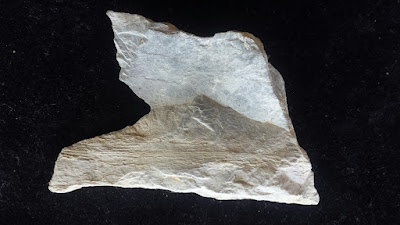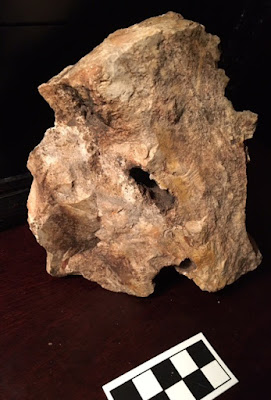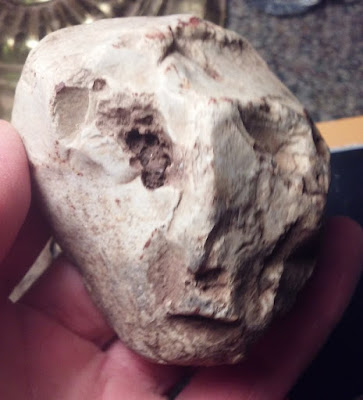'Mammoth right profile with human face carved on its posterior'
Stacy Dodd and Rod Weber find, The Old Route 66 Zoo Site, #23JP1222
Close up of human face along with illustration of features carved in the stone
The 'mammoth with human or feline face at its posterior' rock art motif in North America was first described here and is seen in many examples on this blog.
Abstract - This paper outlines a “symbolic ecology” for the Aurignacian of Central and Southwestern Germany. Drawing upon data derived from cultural anthropology, psychology and zoobiology, we compare the sociocultural modalities of “managing” the recurrent theme of the mammoth and the cave lion with the encounter and interaction conditions underlying these two specific animal-human relations in the glacial landscapes of the European Early Upper Palaeolithic. We propose that being-in-the-world as highly mobile hunter-gatherers living in open and densely populated “animal-landscapes” strongly promotes non-Cartesian understandings of the animal-human interface, ultimately favouring notions of co-habitation, proximity and social intimacy. By reviewing key aspects of mammoth and cave lion ethology and socioecology, we point out the natural significance and relevance of these animals for human forager groups operating in the same environments. Moreover, we argue that this “natural significance” is directly reflected in the archaeological signature of the Central and Southwestern German Aurignacian that assigns these creatures a pre-eminent place in its material culture repertoire – for instance in craftsmanship, subsistence and settlement organisation and thus in areas deeply anchored in every-day practice. Although there is a clear convergence between the natural prominence of these animals and their sociocultural salience, different eco-behavioural profiles of mammoth and cave lion seem to have motivated varying modalities to engage with them materially. This, in turn, suggests different trajectories of constructing the animal-human interface and therefore a different “status” of both animals in the wider “Glaubenswelt” (belief world) of Aurignacian regional communities. The deep entrenchment of both animals in the sociocultural world as well as the rather unique interaction conditions they offer to human co-dwellers point to the social importance of mammoths and cave lions and thus to animistic and essentially relational ontologies. This, finally, demonstrates the blurring of the Cartesian boundary between animal and human domains and introduces the possibility of pondering aspects of “animal-personhood” in this part of the Aurignacian world. We conclude our survey by discussing some critical implications that arise when reading the Middle to Upper Palaeolithic transition from the perspective of animal-human interactions and the entanglement of ontologies and material signatures.
I think these North American feline and mammoth art sculpture observations are either related to an Aurignacian art expression through time and space across an intercontinental mammoth steppe biome or they are a convergent example of how geographically broad and similarly meaningful the glacial human/feline/mammoth landscape and subsistence environment was to the early human experience.





































